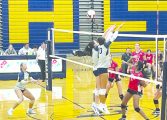Spurred by new government initiatives and public-private partnerships, high schools across the Commonwealth are placing more emphasis on developing curriculum that will prepare students for careers in the high-demand fields of STEM (science, technology, engineering, and math).
“We want to give students a foundation in math and science so they can apply what they have learned here on the college level and go on to have successful careers,” said Brenda Gilliam, director of secondary instruction at Fluvanna County High School.
Fluvanna is already a jump ahead of some school divisions in the state. In 2006, the high school began offering a pre-engineering/engineering technology curriculum through the nationally-acclaimed program called “Project Lead the Way.” Students who complete the coursework can take an examination for dual enrollment credit with participating colleges across the United States.
Joe Mayes teaches the engineering classes at the high school and believes his exploratory classes give students insight into the opportunities available in the field. Students learn design skills using 3-D modeling software, and their class projects include building robots, rockets and hydrogen fuel cells.
Junior William Carothers plans on taking the aerospace class available at the high school in his senior year. “I’d like to become an aerospace engineer. I am interested in space exploration,” he said. Carothers hopes to attend the Queen Mary University of London and earn a Master’s degree in aerospace engineering.
Senior Frank Crivaro plans to enter Piedmont Virginia Community College’s engineering associate of science transfer program after high school. He will continue his education at a Virginia university. “I’m interested in two branches of engineering,” said Crivaro, “I’d like to be either a sonic engineer or a mechanical engineer.”
Practical training is also available for those interested in pursuing jobs in the ever-growing health care industry. The two-year nurse aide program prepares students to take the state licensing examination to become certified nursing assistants. For sports and exercise fans, there are courses offered at the high school to introduce students to careers in physical training and the health sciences.
“I taught the nursing class in Greene County and then left teaching for eight years,” said Karen Grove, teacher of the Nurse Aide classes in Fluvanna. “I had several opportunities to see students that I had taught working in the medical field when I took family members to receive medical care. It is gratifying to see people using the knowledge they learned in high school to contribute to the community and provide for their families. I am teaching these classes again because want to see that continue in Fluvanna.”
The classes teach students about many aspects of heath care.
“I want to be a doctor and this class will help me prepare for my future.” said Cierra Anderson, a junior. “I chose this class because it provides an opportunity to learn about the field I am interested in.”
Gilliam said Fluvanna is also assessing the possibility of becoming a STEM site. More than a dozen STEM academies are currently operating in Virginia, offering curriculum that augments traditional math and science classes with hands-on experiences and projects. Each site functions through partnerships with colleges and local business and industry.
Tenaska Virginia Generating Station is an example of an area company that has invested in education and reaped the benefits of a highly-skilled workforce. Employees of the Scottsville power plant collaborated with Fluvanna’s high school robotics team in the 2008 Virginia Tech Challenge. The company has also provided $40,000 in college scholarships to 54 students from Fluvanna and Buckingham.
Dr. Robert Mayfield is the plant manager and a personal crusader for more job relevant education across the Commonwealth. He serves as chairman of the Virginia Department of Education Career and Technical Education Advisory Committee, which endorses STEM academies in the state.
“Today’s millennial kids are multi-taskers. They are fascinated by technology and they want to know how things work. It can be hard to keep their interest because they want to know the practicality of what they learn,” explained Mayfield.
“That’s what is so great about STEM programs. High school students are using what they learn in the everyday world,” he said. “In math classes, they aren’t just reading from a textbook or looking at a PowerPoint presentation. What they learn has direct application to jobs and careers.”
Having an educated, skilled workforce available is one of the major criteria companies evaluate when they consider moving into a community, said Mayfield. “Yes, water and other concerns are important factors, but if we want economic development in Fluvanna, we need to get our students better prepared for the workforce. They have to receive more than a good education, they need the skill sets that employers are looking for,” he said.
For the past three years, Tenaska has offered a summer internship program to college freshmen and sophomore engineering students. Mayfield said the company received about ten applications last year. Most of the applicants were from Fluvanna and Louisa counties.
Kaela Mattson worked as an intern with Tenaska during the past two summers and plans to graduate from the University of Virginia next May with a degree in civil and environmental engineering.
The Fluvanna County High School graduate said the pre-engineering courses she took increased her exposure to important facets of the profession, including computer drafting and basic programming. Her internship with Tenaska deepened the well of learning experiences far beyond the college classroom as she participated in management and design meetings and assisted in analyzing data for company projects.
“Internships allow you to sample a wide variety of industries and do not need to be strictly in the field that you go to school for,” advised Mattson. “If you do your job well, you have a solid base for references when you apply for a job or graduate education. If not, then it was just another learning experience that does not necessarily impact the rest of your career.”
Dr. Mayfield expects Tenaska to receive even more applications for next summer through Governor McDonnell’s new Commonwealth STEM Industry Internship Program. The program connects college and university students who are majoring in science, technology, engineering, and math with Virginia companies who offer paid internships.
Students and businesses access a no-cost, centralized, online application system. This provides students with the ability to search and apply for summer internship opportunities, and it gives Virginia employers a large pool of qualified students to choose from. Students complete one comprehensive application that will be posted for review by interested companies across the state.
The program is open to full-time undergraduate students taking at least 12 credit hours per semester at an accredited Virginia university, college, or community college or an accredited out-of-state university or college. Students must be at least 18 years old and majoring in STEM disciplines.
To qualify, students must have completed at least 30 or more post-secondary education credits before starting the summer 2013 internship and must be at least a rising sophomore. Seniors graduating at the end of the 2013 spring semester are also eligible to participate.
Virginia companies are encouraged to register and list internship descriptions before Oct. 31 at the Commonwealth STEM industry internship program website: www.csiip.spacegrant.org. The application process will open to students on Nov. 1.
The deadline for student applications is Jan. 31, 2013. Participating businesses can begin accessing the application database Feb. 11, 2013.
(Kathy Zeek contributed to this story.)




